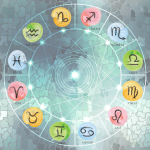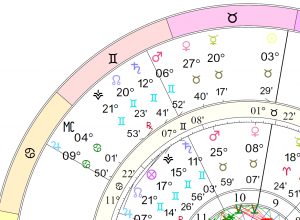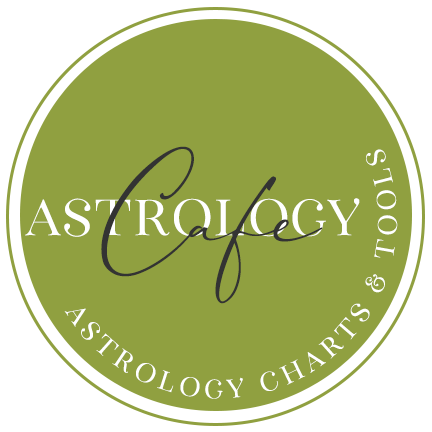Predictive Astrology
Predictive Astrology Techniques:
Techniques for Preparing for the Future and Understanding the Past
 Most astrologers use a variety of techniques to “look into the future” of an individual. There are plenty of techniques used to make predictions — and plan — for the future. Here, are my preferred techniques–transits, secondary progressions, solar arc directions, solar return charts, and more.
Most astrologers use a variety of techniques to “look into the future” of an individual. There are plenty of techniques used to make predictions — and plan — for the future. Here, are my preferred techniques–transits, secondary progressions, solar arc directions, solar return charts, and more.
Transits, for example, challenge and pressure us to make changes in our lives and in our attitudes toward our lives. They bring us joy and sometimes sorrow–they pull out parts of ourselves and “force” us to face them. Secondary progressions reveal our cycles of maturity and growth, showing us how our personalities unfold.
Transits & Cycles
Our natal chart is very much like a snapshot of the sky at the moment we took our first breath. We carry our natal chart with us through the entire course of our lives, even though the planets and luminaries continue their movement and cycles. However, as the planets and points move ahead, they form special relationships to the planets and points in our individual natal charts.
So, for example, if my Sun in my natal chart is at 25 degrees Virgo, and Saturn is moving towards that same degree of Gemini (25 degrees of Gemini), Saturn is said to be transiting square my natal Sun. Similarly, if Saturn is in 25 degrees Gemini, I can look in my natal chart to see where Saturn would fall in terms of house position. If that degree of Gemini is found in my 3rd house, then I would know that Saturn is transiting through my 3rd house.
It is not our aim here to offer tutorials on the technical aspects of transits. We will assume a basic knowledge of the technique so that we can move ahead to interpretation of transits.
Transits act to stimulate what is already there! In other words, they highlight and trigger parts of our own psychological make-up.
Outer Planets First, Inner Planets Later
With transits, it is generally best to first look at the outer planet (slower-moving) transits and cycles in order to get an overview and a “context” before refining our predictions with inner planet cycles and transits. Here are some general guidelines:
- Determine “where a person is at” in an overall achievement sense by looking to where transiting Saturn is by house. Read more about Saturn Transiting Through the Houses.
- Note whether transiting Uranus, Neptune, or Pluto are making major aspects to the individual’s natal Sun, Moon, Mercury, Venus, Mars, Ascendant, or Midheaven. Read about Uranus Transits, Neptune Transits, and Pluto Transits in more detail.
- Determine Saturn’s transits. Read more about Saturn Transits.
- Look to the Jupiter cycle–where is transiting Jupiter by house, and what aspects does it make to natal planets? Read about Jupiter Transits to the planets.
Working “outside in” is best because this way one gets a broader overview of the longer-lasting transits and conditions. This provides better context for the refinements that the inner planet transits offer us.
 Outer planet transits affect us in large chunks–they can be active before the transit is exact by aspect, but we have seen the following: Many times an outer planet transits our natal point once by direct motion, moves forward and then retrogrades back over that point, only to turn direct again and pass that same natal point for the final time in that cycle.
Outer planet transits affect us in large chunks–they can be active before the transit is exact by aspect, but we have seen the following: Many times an outer planet transits our natal point once by direct motion, moves forward and then retrogrades back over that point, only to turn direct again and pass that same natal point for the final time in that cycle.
Generally, the seeds of the transit are being sown in the first part of this cycle (when the transiting planet first “hits” our natal point), and the “problem” or crisis reaches a head during the middle part of this cycle (when the transiting planet retrogrades back over the point). Finally, the situation is resolved around the time the transiting planet moves over our natal point for the final time in the cycle.
Note: we often “see” or “feel” some sense of imminent resolution when the transiting planet goes direct after its retrograde period, before it passes again over our transited point. If our experience of the transit has been a crisis, then we feel marked release at this point. This is likely because a planet going direct after a period of retrogradation is symbolic, in general, of resolve.
In order to understand overall trends and movements in a person’s life, you may also consider the outer planets’ transits through the houses: Jupiter transits the houses, Saturn transits the houses, Uranus transits the houses, Neptune transits the houses, and Pluto transits the houses.
Inner Planet Transits: Power Days, Cycles of Activity, and More
Here are some interesting points to take into account:
- When transiting Moon conjuncts the natal Sun (monthly): These are generally considered “power days”.
- The 2-Year Mars Cycle–Energy Cycle. When transiting Mars nears the sign of your natal Mars, your personal energy increases. Energy wanes as Mars moves away from the sign of your natal Mars and is at its lowest when it transits the opposing sign. For example, if your Mars is in Sagittarius, as transiting Mars moves from Gemini through to Sagittarius, your personal energy increases until it reaches a peak at Sagittarius. When Mars transits the signs following Sagittarius, personal energy decreases until it reaches a low when Mars is in Gemini. This theory was presented in John Townley’s Dynamic Astrology: Using Planetary Cycles to Make Personal and Career Choices (affiliate link).
- When the New Moon contacts a natal planet or point: This suggests a renewed focus in that area of life for a period of approximately one month. If, for example, the New Moon conjuncts our natal Venus, we will experience a “fresh start” and a new perspective in Venus matters (such as love and money). It is also illuminating to interpret the placement of the New Moon by house.
- Read about inner planet transits.
General Cycles & Phenomena
- Mercury Retrograde Cycles
- Venus Retrograde Cycles
- Mars Retrograde Cycles
Secondary Progressions
There are many ways that astrologers “progress” a chart. One of the most popular techniques is called “Secondary Progressions“.
Some of the most significant secondary progressions:
- When the Progressed Sun Changes Sign: Depending on how long a person lives, the progressed Sun changes sign perhaps 3 times in the entire life span. The period when the progressed Sun is very late in a sign and is about to change to a new sign (this occurs for about a year) is often a rather critical year in which many changes occur. When the progressed Sun changes signs, there is usually a very clear change in a person’s general orientation and responses to his or her environment. Plenty of real-life events are possible (such as relocation, a new job in a new field, etc.), but the common theme is starting fresh–“out with the old and in with the new”–and a marked change in the outlook and attitudes of an individual. Before the progressed Sun changes signs, there can be some fear and dread–even a feeling that things are being “taken” from us. Hasty and poor decisions and a sense of urgency can be characteristic of this period. (Read more about the Critical Degrees and their impact in progressions here).
- The Progressed Moon — Cycle of Maturity: The progressed Moon moves through the houses of our natal chart, coming full circle in about 27-28 years. The house it is moving through represents areas of our life that come into focus. We recognize our needs in these areas more intensely, although not necessarily clearly. For example, the progressed Moon moving through the 4th house often brings with it a strong need and search for “roots” and basic life definition. Even though our natal Moon sign “reigns” over our emotional needs in a general sense, our focus shifts as the progressed Moon passes through our houses. In fact, our emotional needs seem to change or shift as the house position changes. Read more about The Progressed Moon Through the Houses (coming soon). The sign of your Progressed Moon indicates the prevailing emotional attitude of that period of time. Read more about The Progressed Moon Through the Signs. Also note that if you look into your past and determine when the progressed Moon passed over any one of the four angles in your chart (that is, the Ascendant, Midheaven, Descendant, and IC) you will see that these progressions/passages often mark rather significant times in your life. Also significant is the progression of the Moon to critical degrees, as well as Progressed Moon in Aspect to Natal Planets and Points.
- The Progressed Lunation Cycle: This is the cycle from one progressed New Moon to the next (every 27-28 years). Look to the phase of the progressed Sun and progressed Moon. During the progressed New Moon phase, individuals instinctively start a new phase or chapter in their lives. The Crescent phase brings about new challenges and opportunities, as well as adjustments, that don’t always feel pleasant, to the new cycle as a purpose is not entirely clear at this point in the cycle. The First Quarter phase represents a particularly active, building stage, while the Gibbous stage presents a time of refining and fine-tuning. This makes way for the Full Moon phase, which is a time of fruition and accomplishment. This marks the beginning of the progressed waning moon phase, when some things dissolve and one begins to recognize the need to let go. The Disseminating phase is a time of sharing and literally “disseminating” that which has been learned in the waxing phase of the moon. The next phase, the Third Quarter Moon phase, marks a time of one’s life when there lies some discontent and dissatisfaction with the way one has been approaching life. This can be a somewhat confusing time, as one instinctively prepares for the final stage of the waning Moon: the Balsamic phase. During this phase, old systems begin to phase out, and there may be a desire for withdrawal and reflection.
- Progressed Planets Conjuncting an Angle of the Natal Chart or Progressed Angles Conjuncting a Natal Planet or Point. These activations involving natal and progressed angles (the Ascendant and Midheaven) generally point to significant personal changes in the native’s life.
- Transits to the Progressed Planets and Points: Transits to progressed planets and angles are extremely significant, and should never be overlooked. For example, transiting Saturn may not be making any significant aspects to our natal chart, but if it is squaring our progressed Sun, we will feel its influence in our lives.
Solar Returns
Solar Return charts are calculated for the exact moment when the Sun returns to its natal position (within 2 days of one’s birthday). These charts can be read much like natal charts, except that it must be kept in mind that they are in effect only for the course of a year (approximately from birthday to birthday).
A Solar Return chart can be read in as much detail as desired. Some key points to consider are as follows:
- The Ascendant of the Solar Return chart will color the individual’s approach to his or her environment for the year. For example, if Aries is on the Ascendant in the Solar Return chart, the individual may approach the year with increased energy and enterprise, and perhaps with some impatience. The ruler of the Ascending sign, and its position by sign, house, and aspect, will hold more information as to the individual’s general temperament and focus.
- Note which planets and points in the natal chart, if any, are effectively brought to an angle of the Solar Return chart. Let’s say, for example, that the Solar Return Ascendant is 22 degrees Virgo, and the natal position of Venus is 24 degrees Virgo. The natal Venus is therefore conjunct the Solar Return Ascendant, and one can presume that the condition and issues surrounding the individual’s natal Venus will be highlighted (effectively coming to the fore) in the Solar Return year. This consideration shows us what natal conditions, or inherent personality issues, are highlighted in the year of the Solar Return. If, for example, you have a natal Sun square Mars, and the sun is on the Solar Return Ascendant, perhaps with Mars on the Midheaven as well, we can safely presume that the Sun-Mars struggle or challenge will be especially highlighted in both a personal (Ascendant) and public (Midheaven) manner.
- Similarly, note which Solar Return planets are on or aspecting Solar Return angles. These are transits that are emphasized in the year of the Solar Return.
- What is the condition of the Sun? Where is it located by house? (We know the sign, of course, because it will be at the exact natal position). This can show an area of focus for the upcoming year. What kind of aspects does it make?
- Where is the Moon? The position of the Moon by house and sign will show where your heart is, so to speak. If, for example, the Solar Return Moon is in Libra in the 5th house, you will likely to be emotionally tied up in, and concentrated on, love and relationship. A strong need for personal self-expression will be characteristic of the year, and emotional ups and downs are likely to occur in this area of life, simply because this is where your heart is–this is the area of life that you have the biggest emotional investment in–and you may not be completely rational and “in control” in this area. More than simple fluctuations will be in store in this area of life if, for example, the Moon is also forming a square to Pluto in the Solar Return chart. Profound changes are likely to occur here. Thus, factoring in the Moon’s aspects will help refine the reading.
- Note that a Solar Return chart can be read much like a natal chart, with the idea that it is transient rather than permanent. If you are interested in looking at a specific area, such as finances, you can study the Return’s second house, eighth house, and the condition of Venus. For example, if Solar Return Venus is opposite Solar Return Neptune, especially if Venus also rules the second house in the Solar Return, you might presume that either this coming year there is less emphasis on materialism, or that your income might be fluctuating and somewhat unstable.
- A consideration that I have found to be particularly significant is critical degrees. The most significant critical degrees in Solar Return interpretation are 29 degrees and 0 degrees of any sign. When found in the SR chart, there can be significant events surrounding the energy of the planet/point itself, and/or the house it rules in the chart. I do look at the classic critical degrees as well, but as a secondary consideration.
- For an insightful and rather thorough analysis of the Solar Return chart, look to Planets in Solar Returns: Yearly Cycles of Transformation & Growth by Mary Fortier Shea**.
Read more about Solar Returns.
Combining Transits and Progressions in Predictive Astrology
In predictive work, we look for more than one activation in order to see a predictive theme in the native’s life. One factor alone, such as progressed Venus square natal Mercury, is generally not enough to predict a significant event occurring in the native’s life. We look for confirmation elsewhere.
An illuminating technique involves creating a tri-wheel with the natal chart in the center, secondary progressions in the second wheel, and transits in the outer (third) wheel. This way we can easily see transits to both the natal chart and the progressed chart, progressed planets in relationship to the natal chart, and progressed planets in relation to other progressed planets. This will help us to see the big picture, in terms of general themes.
If we study transits to the natal chart alone, we will find that significant events are not always confirmed. If we add transits to progressed planets and points to our study, we open up much more detail. Studying progressed planets and points and their relationship to the natal chart (and to each other), our study becomes even more fine-tuned.
We are currently developing this area of the site, where we plan to share our knowledge in the field of Predictive Astrology. There are plenty of techniques used to make predictions for–and plan for–the future. I will be sharing preferred techniques here–transits, secondary progressions, solar arc directions, solar return charts, and more. Please check back often for new additions to this area of the site– I am adding interpretations of specific transits and progressions, as well as guidelines, tips, and “tricks.”
**Please note: Some of my recommended products contain affiliate links. If you purchase a product through my links, I may receive a small commission. I only include these because it comes at NO cost to the buyer. The small commissions I receive help to keep the site up and running. I am a participant in the Amazon Services Associates Program–an affiliate advertising program designed to provide a means for sites to earn advertising fees by advertising and linking to amazon.com and products on that site. I only add links to products that I have personally use or used and genuinely recommend.
Create your free natal chart report and examine your transits with our free report site.












